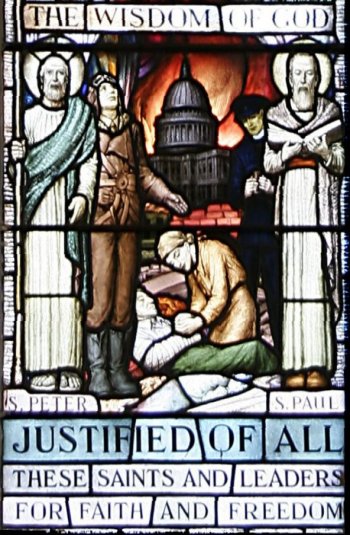
The bottom panel of the middle light depicts an airman in his flying suit. A wounded man is lying on the ground, with a nurse kneeling at his side tending to him. Behind these two, a priest or padre is standing with his prayer book in his hands. The dramatic background depicts St Paul's Cathedral against a sky turned red by the billowing flames and smoke coming from the burning of East London during the Blitz. In his sermon on November 7, 1948, the Sunday before Armistice Day, Maynard spoke of the many different kinds of service rendered by so many different types of men and women during the war. These were all 'wisdom's children' in that "within an evil situation there was redeeming good: ... there was a place for the fruits of faithfulness, self-sacrifice, self-control; devotion to a noble cause; tenderness to the wounded; the courage of the soldier and the courage of the saint."
On the left side of this scene we have the figure of St Peter holding a staff. St Peter is one of the major figures of the New Testament story—from his calling from the life of a fisherman to his leading the Church in Rome, and his martyrdom there. Following Peter's identification of Jesus as "the Christ, the Son of the living God" and Jesus' response: "thou art Peter, and upon this rock I will build my church; and the gates of hell shall not prevail against it. And I will give thee the keys of the kingdom of heaven." (Matthew 16:16-19), Peter has always been seen as a leader among the disciples and, following the resurrection, as a leader of the church. He preached a significant open-air sermon at Pentecost, twice defied the Sanhedrin, and undertook missionary journeys. He was instrumental in the decision to evangelize the Gentiles, and was present at the Council of Jerusalem where Paul further argued the case for accepting Gentiles into the Christian community without the need for circumcision and other trappings of the Mosaic Law (Acts 4-15). Peter's appointment as the first Bishop of Rome, and his subsequent martyrdom there, is well-attested in non-scriptural writings from the first and second centuries. Peter is the Patron Saint of many churches, including this church on the Eastern Hill of the city of Melbourne.